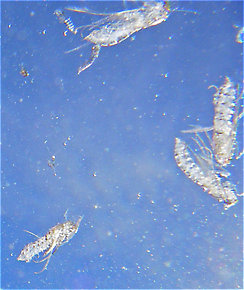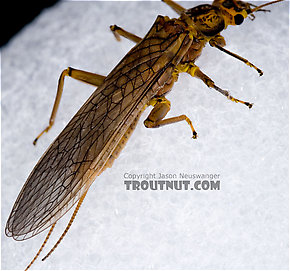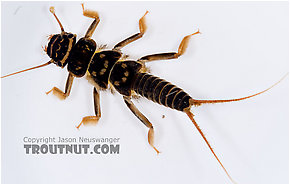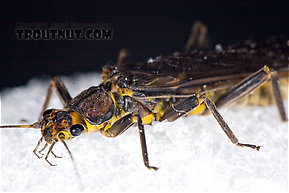Blog & Latest Updates
Fly Fishing Articles
Insects by Common Name


Stonefly Family Perlidae (Golden Stones)
Taxonomic Navigation -?-
Kingdom
Animalia (Animals)
» Phylum
Arthropoda (Arthropods)
» Class
Insecta (Insects)
» Order
Plecoptera (Stoneflies)
» Family Perlidae (Golden Stones)
10 genera aren't included.
Common Names
| Match | Common Name |
| Golden Stones | |
| Big Golden Stones |
Perlidae species are very similar in conformation and habits. With some exceptions, telling them apart can be very difficult East of the Rockies where ten of the genera reside and more than 50 species are involved. With nymphs, differentiating them by subfamily is a good place to start. There are only two: Perlinae - those with an occipital (Occiput: The back of the head.) ridge and row of spinules (often making the back of their heads look concave); Acroneuriinae - those without an occipital (Occiput: The back of the head.) ridge or row of spinules. See the genus and species pages for more information.
Angling literature can be confusing as species of this family were historically referred to as Golden Stoneflies on the West Coast, Brown Willowflies in the Rockies, and in the East they went by a plethora of names. Stone Creeper, American Stonefly, and Common Stonefly were used for the more abundant and usually more somber hued subfamily Acroneuriinae; also present are many often colorful species of the subfamily Perlinae that go by equally colorful names like Yellow Legged Stonefly, Embossed Stonefly, and Beautiful Stonefly. Over time these regional names are going by the wayside as more and more anglers (and the latest angling literature) refer to all of them collectively as Golden Stoneflies.
The nymphs range in coloration from dark brown, delicately patterned gold and amber, to a brilliant yellow and black striped pattern reminiscent of Bengal tigers. The latter description befits them in recognition of their predator status. Their rarely abundant populations and nocturnal habits make them limited in importance back East, but out West, the story is quite different.
In the Rocky Mountain and Pacific Coast States, perlids exist in tremendous numbers and perhaps more importantly, they are very active during daylight hours. Ironically, in spite of the large populations the entire family is represented by only eight species in six genera and of those, by far the largest populations involve only two, Calineuria californica and the equally common Hesperoperla pacifica. Certain characteristics allow the angler to easily tell these western species apart in the hand by comparing head markings and the presence or absence of anal gills on the nymphs. The adults are easily sorted as well by knowing the different hammer (Hammer: A smooth clearly defined chitinous area on the ventral surface of the ninth abdominal segment of some male stoneflies used for drumming up mates.) shapes of the males and dorsal (Dorsal: Top.) markings of both sexes.
Taxonomic revisions have moved four of the five western species formerly classified under Acroneuria to new genera, though like the two already mentioned, they are easily recognized in the taxa lists by their retained species names. All remaining Acroneuria species are now east of the Rockies.
Hatching Behavior
Eastern and Midwestern reporting suggests their emergence activity is primarily nocturnal. In the West, the opposite is true. This fact, coupled with dense populations explains their importance to anglers on many western rivers.
They emerge in typical stonefly fashion by crawling out onto rocks or riparian foliage where ecdysis (Ecdysis: the process of casting the skin; moulting) occurs. Their cast-off shucks (

Here's an underwater view of the pupal shucks of several already-emerged Brachycentrus numerosus caddisflies.
Egg-Laying Behavior
Mating takes place terrestrially. In the East their ovipositing behavior is so spread out that angling opportunities based on it are rare.
On western rivers, the mating swarms can be so thick on overhanging grasses and foliage that they often collapse under the weight providing a real smorgasbord for the waiting trout downstream. The large females returning to the water to lay their eggs provide the best opportunity for anglers. Some species skitter, some drop from the air and others will land to to drop there large dark egg sacks. Regardless of method, the ever present western breezes ensure that plenty of them end up on the water.
Perlidae Fly Fishing Tips
Effective nymph imitations run from simple chenille rubber-legged models to as complex as you dare risk losing in the rocks. Debate rages over the need to imitate "eyeballs and elbows", especially in swift water "rock gardens" out West. Heavy western water is where an hour's worth of work at the vise can be lost in a matter of seconds. Resolution may hinge on the water type fished. Presenting the fly to discriminating fish picking off migrating nymphs in calmer shallows requires lighter swimming patterns that need to be more imitative. Dredging swift 5 ft. deep currents full of big rocks presents fly design considerations of an entirely different order. Dead drifting patterns deeply through calmer or more intimate waters requires still another solution.
Molting nymphs offer another area of opportunity. Creamy patterns are gaining increasing acceptance as searching patterns (Searching pattern: Any artificial fly pattern used when trout that aren't feeding selectively on anything in particular. A searching pattern may be an attractor or an imitation of something specific that the fish might favor even though it's not currently hatching.) in recognition of this. It is undeniable that large perlids after molting present an easy to see and tempting entree if caught in the drift.
The type of water where trout and perlids interact has similar influence on dry fly selection as well. Bushy hair wings and rubber legs have their place in big water, as do slimmer flush floating designs at the margins.
In the East, nymph imitations of this family are often turned to as searching patterns (Searching pattern: Any artificial fly pattern used when trout that aren't feeding selectively on anything in particular. A searching pattern may be an attractor or an imitation of something specific that the fish might favor even though it's not currently hatching.) when nothing is hatching. Both dry and nymph imitations are popular with western anglers for use any time during the Spring and Summer, not just when matching the hatch.
Pictures of 41 Stonefly Specimens in the Family Perlidae:
Female Acroneuria lycorias (Golden Stone) Stonefly Adult View 17 Pictures
View 17 Pictures
 View 17 Pictures
View 17 PicturesCollected May 23, 2007 from Aquarium (collected somewhere in Catskills) in New York
Added to Troutnut.com by Troutnut on June 4, 2007
Added to Troutnut.com by Troutnut on June 4, 2007
Acroneuria abnormis (Golden Stone) Stonefly Nymph View 12 Pictures
View 12 Pictures
 View 12 Pictures
View 12 PicturesCollected May 6, 2007 from Mongaup Creek in New York
Added to Troutnut.com by Troutnut on May 18, 2007
Added to Troutnut.com by Troutnut on May 18, 2007
Paragnetina (Golden Stones) Stonefly Adult View 10 PicturesUnfortunately I forgot to photograph this one next to the ruler, but I seem to remember it being on the small side for a Perlid, maybe around 2cm.
View 10 PicturesUnfortunately I forgot to photograph this one next to the ruler, but I seem to remember it being on the small side for a Perlid, maybe around 2cm.
 View 10 PicturesUnfortunately I forgot to photograph this one next to the ruler, but I seem to remember it being on the small side for a Perlid, maybe around 2cm.
View 10 PicturesUnfortunately I forgot to photograph this one next to the ruler, but I seem to remember it being on the small side for a Perlid, maybe around 2cm.Recent Discussions of Perlidae
Perlesta placida 14 Replies »
Posted by Mad4Trout on Jul 3, 2011 in the species Perlesta placida
Last reply on Nov 27, 2011 by Mad4Trout
I don't know why "Stoneflies of the United States" has such a limited range for Perlesta placida, but we (Madmen Chapter of TU) have collected them on the Mad River, Logan Co., OH. They were reported by Gaufin (1956, Ohio J. Sci. 56 (6):321-324) in numerous counties. They have been recorded more recently by Ohio EPA.
ReplyCultus verticalis? 8 Replies »Posted by DOS on Mar 31, 2009 in the species Agnetina capitata
Last reply on Apr 1, 2009 by Troutnut
Hello gentlemen,
Again I come to you for guidance...
While monkeying around today in the aquarium, I flipped over a rock and this guy came scurrying out. I have recently been studying A. capitata and realized immediately that this might be a different species. Until now, I had thought that A. capitata was the only "golden stone" I had collected here in WNY to date, however I guess now I have one more under my belt! Is it weird that this excites me??
When I do my collecting on the stream and bring the insects home, I attempt to snap a pic of each before I place them in the aquarium, sort of a photographic inventory. This guy must have been hiding somewhere and was overlooked in that process.
So, anyone want to go out on a limb and confirm this as Cultus verticalis? Other than a measured length of 19mm, I can't really offer up any identifying features that aren't visible in the pictures. I don't have access to the M&C key. Anyone know if its posted online? I'll search my school library in a moment.
If it is C. verticalis, I've noticed that neither genus or species appear on the USGS Stoneflies of New York list. I see that Jason originally coded his specimen to the genus Arcynopteryx which contains three species. Again, none appear anywhere near WNY on the USGS list. Any other ideas of a possible alternative ID? http://www.npwrc.usgs.gov/resource/distr/insects/sfly/ny/toc.htm
If its not on the list, anyone know if and how I can submit my findings? Also, what is your experience with the USGS lists in regards to its accuracy and completeness? This and other instances have me thinking there are some holes in the data.
Unfortunately, this specimen perished as I was photographing it. I was hoping it would survive so that it might emerge and I could get snap photos as an adult. Tomorrow I'm heading to the location where I collected him to see if I can determine abundance in relation to A. capitata, as obviously the share the same lotic environment.
Thanks in advance!
(User-posted images are only viewable in the forum section.)
(User-posted images are only viewable in the forum section.)
(User-posted images are only viewable in the forum section.)
To enlarge the photos, you can right click ---> copy image location ---> then paste the URL in your browser
ReplyAgain I come to you for guidance...
While monkeying around today in the aquarium, I flipped over a rock and this guy came scurrying out. I have recently been studying A. capitata and realized immediately that this might be a different species. Until now, I had thought that A. capitata was the only "golden stone" I had collected here in WNY to date, however I guess now I have one more under my belt! Is it weird that this excites me??
When I do my collecting on the stream and bring the insects home, I attempt to snap a pic of each before I place them in the aquarium, sort of a photographic inventory. This guy must have been hiding somewhere and was overlooked in that process.
So, anyone want to go out on a limb and confirm this as Cultus verticalis? Other than a measured length of 19mm, I can't really offer up any identifying features that aren't visible in the pictures. I don't have access to the M&C key. Anyone know if its posted online? I'll search my school library in a moment.
If it is C. verticalis, I've noticed that neither genus or species appear on the USGS Stoneflies of New York list. I see that Jason originally coded his specimen to the genus Arcynopteryx which contains three species. Again, none appear anywhere near WNY on the USGS list. Any other ideas of a possible alternative ID? http://www.npwrc.usgs.gov/resource/distr/insects/sfly/ny/toc.htm
If its not on the list, anyone know if and how I can submit my findings? Also, what is your experience with the USGS lists in regards to its accuracy and completeness? This and other instances have me thinking there are some holes in the data.
Unfortunately, this specimen perished as I was photographing it. I was hoping it would survive so that it might emerge and I could get snap photos as an adult. Tomorrow I'm heading to the location where I collected him to see if I can determine abundance in relation to A. capitata, as obviously the share the same lotic environment.
Thanks in advance!
(User-posted images are only viewable in the forum section.)
(User-posted images are only viewable in the forum section.)
(User-posted images are only viewable in the forum section.)
To enlarge the photos, you can right click ---> copy image location ---> then paste the URL in your browser
Your Thoughts On Perlidae:
Top 10 Fly Hatches
Top Gift Shop Designs
Eat mayflies.
Top Insect Specimens
Miscellaneous Sites
Troutnut.com is copyright © 2004-2024 Jason
Neuswanger (email Jason). See my FAQ for information about use of my images.
 privacy policy
privacy policy
